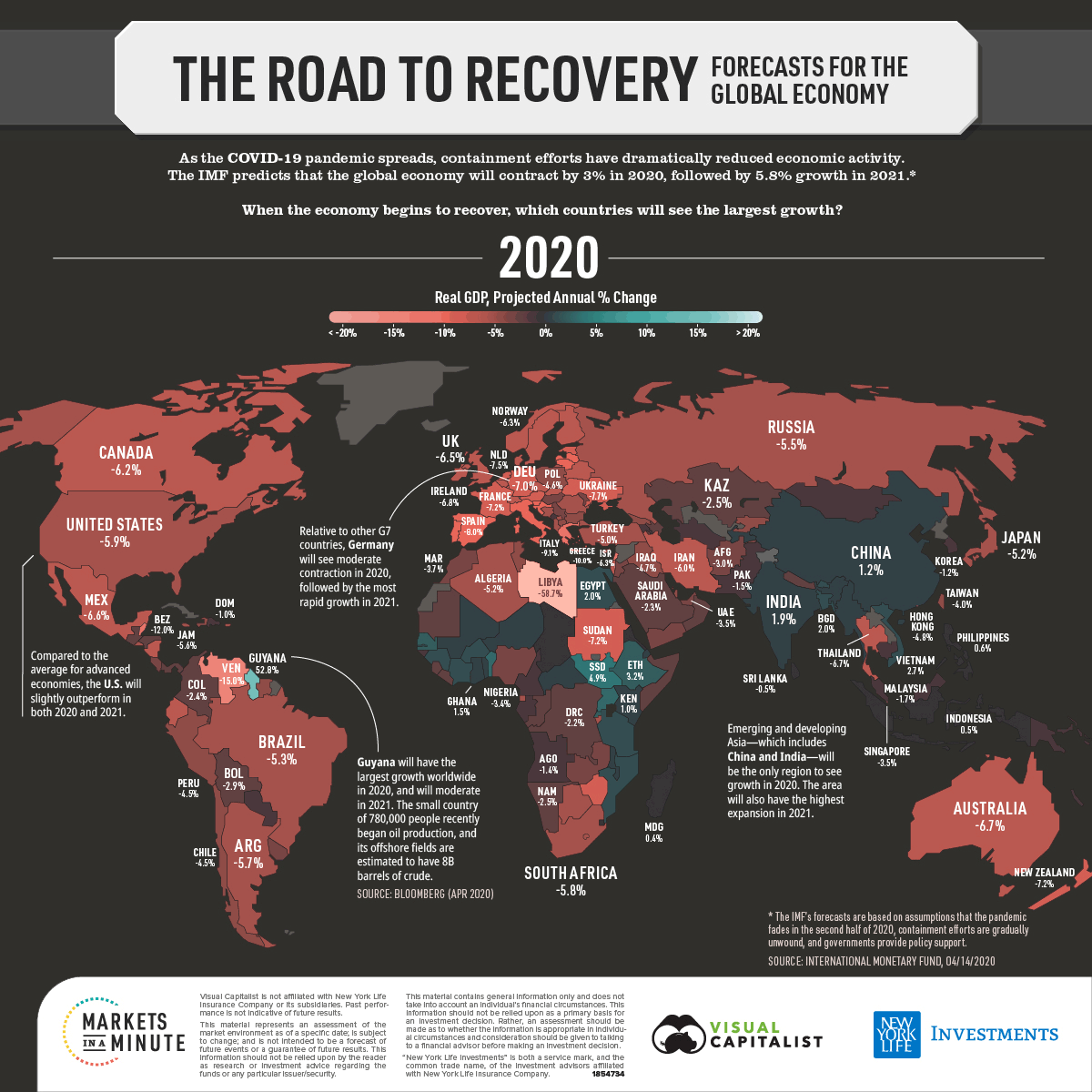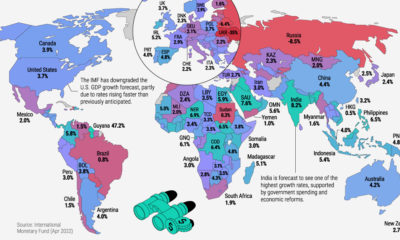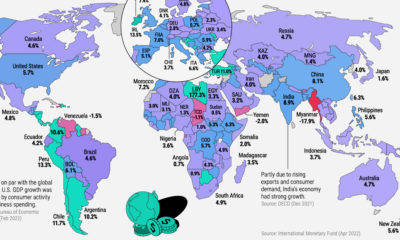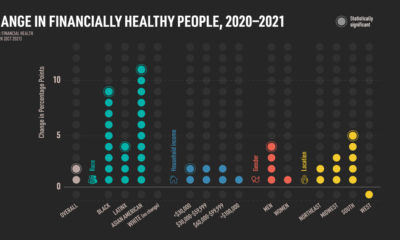This Markets in a Minute Chart is available as a poster.
COVID-19 Recovery: A Global Economic Forecast
As governments enact COVID-19 containment measures, economies around the world have slowed to a crawl. Many people find themselves out of work, and businesses are struggling to stay afloat amid strict regulations and plummeting demand.
However, while current economic conditions are bleak, some forecasts for the upcoming recovery provide room for investor optimism. According to the most recent forecast from the International Monetary Fund (IMF), it’s projected that the global economy will contract by 3% in 2020, followed by 5.8% growth in 2021.
In today’s Markets in a Minute from New York Life Investments, we take a look at the country-level economic forecast to highlight which areas may recover the fastest.
Emerging from The Great Lockdown
Given the numerous uncertainties COVID-19 brings, preparing an economic forecast was no easy task. The IMF’s most recent projections assume that the pandemic fades in the second half of 2020, containment efforts are gradually unwound, and governments provide policy support.
With this in mind, which countries are expected to see the strongest recoveries? Below is the full country-level forecast, sorted by projected real GDP growth in 2021.
Real GDP, Annual Percentage Change
2019 Actual, 2020-2021 Projected
| Jurisdiction | 2019 | 2020P | 2021P |
| Libya | 9.9 | –58.7 | 80.7 |
| Macao SAR | –4.7 | –29.6 | 32.0 |
| Palau | 0.5 | –11.9 | 14.4 |
| Maldives | 5.7 | –8.1 | 13.2 |
| Aruba | 0.4 | –13.7 | 12.1 |
| Bangladesh | 7.9 | 2.0 | 9.5 |
| China | 6.1 | 1.2 | 9.2 |
| Malaysia | 4.3 | –1.7 | 9.0 |
| Côte d'Ivoire | 6.9 | 2.7 | 8.7 |
| St. Kitts and Nevis | 2.9 | –8.1 | 8.5 |
| Djibouti | 7.5 | 1.0 | 8.5 |
| Latvia | 2.2 | –8.6 | 8.3 |
| Lithuania | 3.9 | –8.1 | 8.2 |
| Indonesia | 5.0 | 0.5 | 8.2 |
| Niger | 5.8 | 1.0 | 8.1 |
| Mongolia | 5.1 | –1.0 | 8.0 |
| Albania | 2.2 | –5.0 | 8.0 |
| Antigua and Barbuda | 5.3 | –10.0 | 8.0 |
| Kyrgyz Republic | 4.5 | –4.0 | 8.0 |
| Seychelles | 3.9 | –10.8 | 8.0 |
| Estonia | 4.3 | –7.5 | 7.9 |
| Philippines | 5.9 | 0.6 | 7.6 |
| Belize | 0.3 | –12.0 | 7.6 |
| Guinea | 5.6 | 2.9 | 7.6 |
| Czech Republic | 2.6 | –6.5 | 7.5 |
| Myanmar | 6.5 | 1.8 | 7.5 |
| Kosovo | 4.0 | –5.0 | 7.5 |
| Serbia | 4.2 | –3.0 | 7.5 |
| India | 4.2 | 1.9 | 7.4 |
| Iraq | 3.9 | –4.7 | 7.2 |
| Barbados | –0.1 | –7.6 | 7.1 |
| Malta | 4.4 | –2.8 | 7.0 |
| Fiji | 0.5 | –5.8 | 7.0 |
| Vietnam | 7.0 | 2.7 | 7.0 |
| North Macedonia | 3.6 | –4.0 | 7.0 |
| Uzbekistan | 5.6 | 1.8 | 7.0 |
| St. Lucia | 1.7 | –8.5 | 6.9 |
| Botswana | 3.0 | –5.4 | 6.8 |
| The Bahamas | 1.8 | –8.3 | 6.7 |
| Rwanda | 10.1 | 3.5 | 6.7 |
| Montenegro | 3.6 | –9.0 | 6.5 |
| The Gambia | 6.0 | 2.5 | 6.5 |
| Turkmenistan | 6.3 | 1.8 | 6.4 |
| Ireland | 5.5 | –6.8 | 6.3 |
| Guyana | 4.7 | 52.8 | 6.3 |
| Algeria | 0.7 | –5.2 | 6.2 |
| Australia | 1.8 | –6.7 | 6.1 |
| Cambodia | 7.0 | –1.6 | 6.1 |
| Thailand | 2.4 | –6.7 | 6.1 |
| Grenada | 3.1 | –8.0 | 6.1 |
| Yemen | 2.1 | –3.0 | 6.1 |
| Chad | 3.0 | –0.2 | 6.1 |
| Kenya | 5.6 | 1.0 | 6.1 |
| Denmark | 2.4 | –6.5 | 6.0 |
| Iceland | 1.9 | –7.2 | 6.0 |
| Bulgaria | 3.4 | –4.0 | 6.0 |
| Benin | 6.4 | 4.5 | 6.0 |
| New Zealand | 2.2 | –7.2 | 5.9 |
| Eritrea | 3.8 | 0.1 | 5.9 |
| Ghana | 6.1 | 1.5 | 5.9 |
| Mauritius | 3.5 | –6.8 | 5.9 |
| Burkina Faso | 5.7 | 2.0 | 5.8 |
| Cyprus | 3.2 | –6.5 | 5.6 |
| Lao P.D.R. | 4.7 | 0.7 | 5.6 |
| Guatemala | 3.6 | –2.0 | 5.5 |
| Tajikistan | 7.5 | 1.0 | 5.5 |
| Cabo Verde | 5.5 | –4.0 | 5.5 |
| São Tomé and Príncipe | 1.3 | –6.0 | 5.5 |
| Senegal | 5.3 | 3.0 | 5.5 |
| Slovenia | 2.4 | –8.0 | 5.4 |
| San Marino | 1.1 | –12.2 | 5.4 |
| St. Vincent and the Grenadines | 0.4 | –4.5 | 5.4 |
| Chile | 1.1 | –4.5 | 5.3 |
| Germany | 0.6 | –7.0 | 5.2 |
| Sweden | 1.2 | –6.8 | 5.2 |
| Peru | 2.2 | –4.5 | 5.2 |
| Greece | 1.9 | –10.0 | 5.1 |
| Lesotho | 1.2 | –5.2 | 5.1 |
| Portugal | 2.2 | –8.0 | 5.0 |
| Slovak Republic | 2.3 | –6.2 | 5.0 |
| Israel | 3.5 | –6.3 | 5.0 |
| Nepal | 7.1 | 2.5 | 5.0 |
| Turkey | 0.9 | –5.0 | 5.0 |
| Uruguay | 0.2 | –3.0 | 5.0 |
| Qatar | 0.1 | –4.3 | 5.0 |
| Madagascar | 4.8 | 0.4 | 5.0 |
| Vanuatu | 2.9 | –3.3 | 4.9 |
| Croatia | 2.9 | –9.0 | 4.9 |
| Suriname | 2.3 | –4.9 | 4.9 |
| Italy | 0.3 | –9.1 | 4.8 |
| Luxembourg | 2.3 | –4.9 | 4.8 |
| Armenia | 7.6 | –1.5 | 4.8 |
| Morocco | 2.2 | –3.7 | 4.8 |
| United States | 2.3 | –5.9 | 4.7 |
| Mozambique | 2.2 | 2.2 | 4.7 |
| Belgium | 1.4 | –6.9 | 4.6 |
| Tanzania | 6.3 | 2.0 | 4.6 |
| France | 1.3 | –7.2 | 4.5 |
| Austria | 1.6 | –7.0 | 4.5 |
| El Salvador | 2.4 | –5.4 | 4.5 |
| Afghanistan | 3.0 | –3.0 | 4.5 |
| Argentina | –2.2 | –5.7 | 4.4 |
| Spain | 2.0 | –8.0 | 4.3 |
| Ethiopia | 9.0 | 3.2 | 4.3 |
| Uganda | 4.9 | 3.5 | 4.3 |
| Canada | 1.6 | –6.2 | 4.2 |
| Sri Lanka | 2.3 | –0.5 | 4.2 |
| Hungary | 4.9 | –3.1 | 4.2 |
| Poland | 4.1 | –4.6 | 4.2 |
| Mauritania | 5.9 | –2.0 | 4.2 |
| Burundi | 1.8 | –5.5 | 4.2 |
| Moldova | 3.6 | –3.0 | 4.1 |
| Honduras | 2.7 | –2.4 | 4.1 |
| Kazakhstan | 4.5 | –2.5 | 4.1 |
| Tunisia | 1.0 | –4.3 | 4.1 |
| Cameroon | 3.7 | –1.2 | 4.1 |
| Mali | 5.1 | 1.5 | 4.1 |
| United Kingdom | 1.4 | –6.5 | 4.0 |
| Dominican Republic | 5.1 | –1.0 | 4.0 |
| Panama | 3.0 | –2.0 | 4.0 |
| Paraguay | 0.2 | –1.0 | 4.0 |
| Central African Republic | 3.0 | 1.0 | 4.0 |
| Liberia | –2.5 | –2.5 | 4.0 |
| Sierra Leone | 5.1 | –2.3 | 4.0 |
| South Africa | 0.2 | –5.8 | 4.0 |
| Togo | 5.3 | 1.0 | 4.0 |
| Hong Kong SAR | –1.2 | –4.8 | 3.9 |
| Romania | 4.1 | –5.0 | 3.9 |
| Ecuador | 0.1 | –6.3 | 3.9 |
| Switzerland | 0.9 | –6.0 | 3.8 |
| Solomon Islands | 1.2 | –2.1 | 3.8 |
| Timor-Leste | 3.1 | –3.0 | 3.8 |
| Colombia | 3.3 | –2.4 | 3.7 |
| Jordan | 2.0 | –3.7 | 3.7 |
| Ukraine | 3.2 | –7.7 | 3.6 |
| Gabon | 3.4 | –1.2 | 3.6 |
| Taiwan Province of China | 2.7 | –4.0 | 3.5 |
| Brunei Darussalam | 3.9 | 1.3 | 3.5 |
| Tuvalu | 6.0 | –1.0 | 3.5 |
| Belarus | 1.2 | –6.0 | 3.5 |
| Bosnia and Herzegovina | 2.7 | –5.0 | 3.5 |
| Russia | 1.3 | –5.5 | 3.5 |
| Jamaica | 1.0 | –5.6 | 3.5 |
| Democratic Republic of the Congo | 4.4 | –2.2 | 3.5 |
| Korea | 2.0 | –1.2 | 3.4 |
| Dominica | 9.2 | –4.7 | 3.4 |
| Kuwait | 0.7 | –1.1 | 3.4 |
| Republic of Congo | –0.9 | –2.3 | 3.4 |
| United Arab Emirates | 1.3 | –3.5 | 3.3 |
| Marshall Islands | 2.4 | –0.2 | 3.2 |
| Namibia | –1.4 | –2.5 | 3.2 |
| South Sudan | 11.3 | 4.9 | 3.2 |
| Finland | 1.0 | –6.0 | 3.1 |
| Iran | –7.6 | –6.0 | 3.1 |
| Comoros | 1.9 | –1.2 | 3.1 |
| Netherlands | 1.8 | –7.5 | 3.0 |
| Japan | 0.7 | –5.2 | 3.0 |
| Singapore | 0.7 | –3.5 | 3.0 |
| Costa Rica | 2.1 | –3.3 | 3.0 |
| Mexico | –0.1 | –6.6 | 3.0 |
| Bahrain | 1.8 | –3.6 | 3.0 |
| Georgia | 5.1 | –4.0 | 3.0 |
| Oman | 0.5 | –2.8 | 3.0 |
| Guinea-Bissau | 4.6 | –1.5 | 3.0 |
| Norway | 1.2 | –6.3 | 2.9 |
| Bhutan | 5.3 | 2.7 | 2.9 |
| Papua New Guinea | 5.0 | –1.0 | 2.9 |
| Bolivia | 2.8 | –2.9 | 2.9 |
| Brazil | 1.1 | –5.3 | 2.9 |
| Saudi Arabia | 0.3 | –2.3 | 2.9 |
| Somalia | 2.9 | –2.5 | 2.9 |
| Egypt | 5.6 | 2.0 | 2.8 |
| Trinidad and Tobago | –0.0 | –4.5 | 2.6 |
| Angola | –1.5 | –1.4 | 2.6 |
| Malawi | 4.5 | 1.0 | 2.5 |
| Zimbabwe | –8.3 | –7.4 | 2.5 |
| Nigeria | 2.2 | –3.4 | 2.4 |
| Equatorial Guinea | –6.1 | –5.5 | 2.3 |
| Zambia | 1.5 | –3.5 | 2.3 |
| Kiribati | 2.3 | 0.0 | 2.2 |
| Pakistan | 3.3 | –1.5 | 2.0 |
| Eswatini | 1.0 | –0.9 | 1.8 |
| Puerto Rico | 2.0 | –6.0 | 1.5 |
| Micronesia | 1.2 | –0.4 | 1.4 |
| Nauru | 1.0 | –1.7 | 1.3 |
| Tonga | –0.1 | –1.2 | 1.2 |
| Haiti | –1.2 | –4.0 | 1.2 |
| Azerbaijan | 2.3 | –2.2 | 0.7 |
| Samoa | 3.5 | –3.7 | 0.5 |
| Nicaragua | –3.9 | –6.0 | 0.0 |
| Sudan | –2.5 | –7.2 | –3.0 |
| Venezuela | –35.0 | –15.0 | –5.0 |
| Lebanon | –6.5 | –12.0 | No data |
| Syria | No data | No data | No data |
Libya is forecast to have the highest growth in 2021, as well as the deepest contraction in 2020. However, the IMF notes the reliability of this data is low given Libya is currently facing a civil war and weak capacity.
Emerging and developing Asia is expected to have a strong recovery, with China and India predicted to see 2021 growth rates of 9.2% and 7.4% respectively. For China, this is a welcome change after its first quarter GDP contracted by 6.8%, the first decline since at least 1992.
The IMF predicts the U.S. will see GDP growth of 4.7% in 2021, which is slightly higher than the 4.5% average for advanced economies. Separately, the U.S. Federal Reserve also believes the economy will recover relatively quickly given the country entered the pandemic on strong economic footing.
There is every reason to believe that the economic rebound, when it comes, can be robust.
—Jerome Powell, U.S. Federal Reserve Chairman
In the meantime, the Federal Reserve says it is committed to providing financing programs and maintaining low interest rates to help boost the economy.
Spotting Opportunity
As the pandemic subsides, broad-based stimulus will be critical for economic recoveries. Clear communication on the state of the pandemic, and the decline of new infections, will also help instill consumer confidence.
Investors can consider these factors, as well as the IMF’s forecast, as they look to diversify geographically. This allows investors to take advantage of areas with the highest potential growth.




 Infographics2 years ago
Infographics2 years ago
 Markets in a Minute2 years ago
Markets in a Minute2 years ago
 Markets in a Minute2 years ago
Markets in a Minute2 years ago
 Infographics2 years ago
Infographics2 years ago
 Markets in a Minute1 year ago
Markets in a Minute1 year ago
 Infographics3 years ago
Infographics3 years ago
 Markets in a Minute2 years ago
Markets in a Minute2 years ago
 Infographics1 year ago
Infographics1 year ago


















